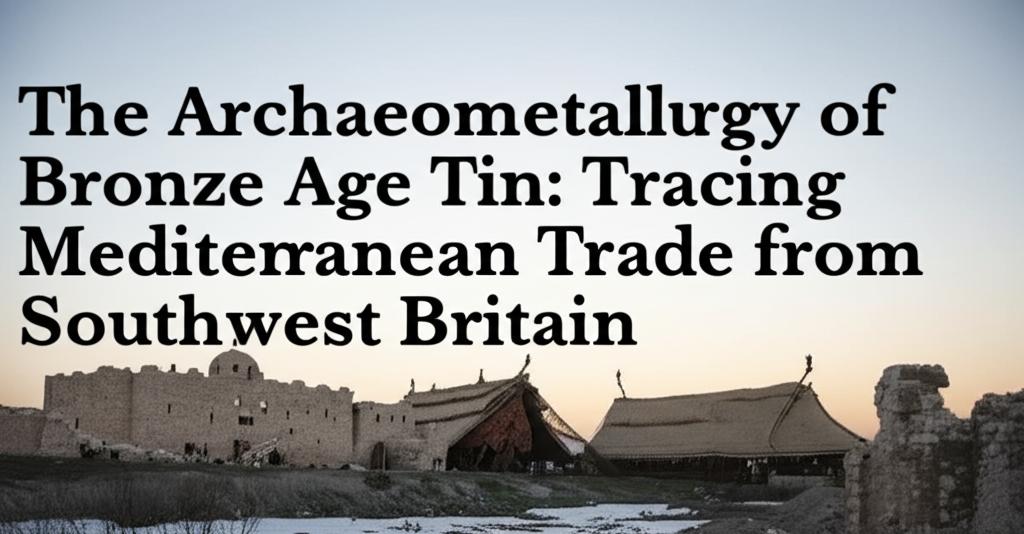The story of Bronze Age tin, particularly its extraction in Southwest Britain and subsequent trade across the Mediterranean, has been a long-standing puzzle for archaeologists. However, recent advancements in archaeometallurgy are shedding new light on this ancient network, revealing the crucial role British tin played in the technological and cultural transformations of the Bronze Age.
For over two centuries, researchers have debated the primary sources of tin that fueled the Bronze Age, a period defined by the widespread use of bronze – an alloy typically composed of 90% copper and 10% tin. While copper sources were relatively common across Eurasia, tin was far rarer, making its origin a significant question. The rich and accessible tin deposits in Cornwall and Devon in Southwest Britain have long been considered potential candidates, but definitive proof of their extensive exploitation and long-distance trade during the Bronze Age was elusive until recently.
Groundbreaking new research, primarily employing a sophisticated combination of trace element analysis, lead isotope analysis, and tin isotope analysis, has provided compelling evidence. Archaeologists, notably Dr. Alan Williams and Dr. Benjamin Roberts from Durham University, have spearheaded studies analyzing tin ores from Cornwall and Devon, alongside tin artifacts recovered from various European locations and, significantly, from ancient shipwrecks in the Mediterranean.
These meticulous analyses have demonstrated a clear chemical and isotopic match between tin ingots found in shipwrecks off the coasts of Israel (dating to around 1300 BC) and southern France (dating to around 600 BC) and the tin ores originating from Southwest Britain. This indicates that tin mined by what were likely small farming communities in Cornwall and Devon was transported over vast distances, reaching major Bronze Age civilizations in the Eastern Mediterranean, some 4,000 kilometers (2,500 miles) away.
This discovery is transformative, suggesting that British tin was a major commodity that facilitated the full transition from copper to bronze use in Eastern Mediterranean civilizations. It positions Southwest Britain not as an isolated periphery, but as a vital node in a vast, pan-continental trade network. This trade likely involved a complex system of maritime and riverine routes, possibly passing through intermediaries, as evidenced by Cypro-Minoan script markings found on some tin ingots discovered in the Eastern Mediterranean – a script unlikely to have been known to the Cornish tin miners themselves.
The scale of this trade is also being re-evaluated. Estimates suggest that hundreds of tons of tin a year may have originated from Southwest Britain. This volume indicates a far more sophisticated level of mining, processing, and trade organization than previously imagined for the Bronze Age, particularly accomplished without widespread literacy or centralized state structures in the source region.
Furthermore, these findings lend scientific support to ancient historical accounts, such as those by the Greek explorer Pytheas who, around 320 BC, described a tin trading center in Southwest Britain, possibly an island he called Ictis (long suspected by some scholars to be St. Michael's Mount in Cornwall). Pytheas detailed how tin was transported across the sea and then via rivers through France to reach the Mediterranean. The analysis of tin from the Rochelongue shipwreck off the French coast, provenanced to Cornwall, provides direct archaeological evidence for this described trade route.
While the importance of British tin is becoming clearer, the debate is not entirely settled. Some researchers still point to Central Asian sources as also being significant throughout the Bronze Age, particularly for earlier periods or specific regions. It is likely that multiple tin sources were exploited to meet the high demand of Bronze Age societies. However, the latest evidence strongly suggests that by the Late Bronze Age, tin from Southwest Britain played a dominant role in supplying the Mediterranean world.
Ongoing research continues to refine our understanding of these ancient trade routes, the socio-economic structures that supported them, and the full impact of this long-distance exchange on the diverse cultures of the Bronze Age. The "tin problem" is gradually being solved, revealing a remarkable story of interconnectedness and technological advancement driven, in significant part, by the mineral wealth of Southwest Britain.

